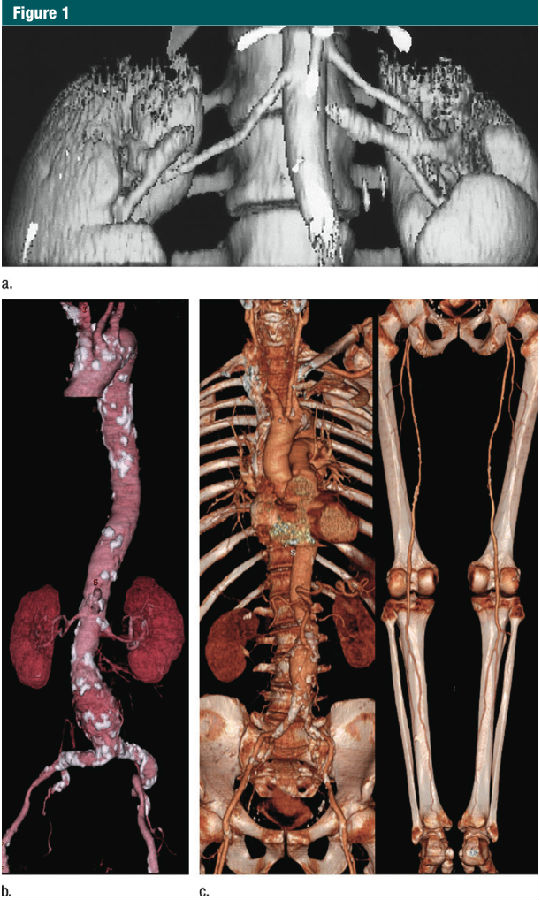|
作者:Geoffrey D. Rubin, MD
作者单位:Duke Clinical Research Institute, 2400 Pratt St 本文发表于:Radiology: Volume 271: Number 3—June 2014 radiology.rsna.org 翻译:郑颖;校对:张帅、陆伟;整理:梁军
上期回顾: 本综述回顾了CT血管造影术的演进,从其发展和早期挑战到成熟产品,提供对于心血管疾病发现和治疗独有的视野。
本期内容:
CTA的起源,初期的瓶颈以及解决的方法
CTA的起源 Emergence of Angiography CT血管造影(CTA)得以实现的主要技术支持是在1990年临床上引入了螺旋(6、7)扫描,标志着进入容积CT时代。它的主要贡献是取代了“步进扫描”(step and shoot)的采集模式。该模式是在一次横断位图像采集的时候,扫描床是静止的,而在下一次机架旋转重启扫描前,扫描床前移至下一个扫描位置。螺旋扫描是在扫描床进动中连续采集,可在单位时间内覆盖更大的扫描范围。
The primary enabling technology for CT angiography was the clinicalintroduction of spiral& #40;6& #41;or helical& #40;7& #41; scanning in 1990, which ushered in the era of volumetric CT. Its key contribution was thereplacement of the “step and shoot” acquisition mode, in which the table wasstatic during the acquisition of a single transverse section and subsequentlyadvanced to the next scan position before gantry rotation resumed, with continuousacquisition of projections during table travel that allowed coverage of muchlarger volumes per unit time.
其他方面的优势是可以采集静脉团注对比剂的首过(动脉期),当它流经特定的血管区域。在早期,床速受限于机架每转的层厚,例如,机架每转1秒,层厚3mm,则床速为3mm/秒。另一个限制就是X光球管热容量,它限定毫安量(也因此噪声增加),及扫描时间小于30秒,结果同样的扫描参数下最大覆盖范围是225px(8)。 Among other advantages, this permitted the capture of the first pass of anintravenous contrast agent bolus as it transited a particular vascularterritory. In those early days, table speed was limited to the sectionthickness per gantry rotation; thus, for example, given a 1-second gantryrotation and 3-mm sections, table speed was 3 mm/sec. Another limitation wasx-ray tube heat capacity, limiting milliamperage & #40;and, thereby, in- creasingnoise& #41; and scan time to less than 30 seconds, resulting in a maxi- mum coveragewith the same parameters of 9 cm& #40;8& #41;.
第一篇描述CT血管造影(CTA)的文章发表在1992年11月的放射学(Radiology)杂志上& #40;9、10& #41;,并且展示了快速容积覆盖与3D可视化的可能性。 The first articles describing CT angiography appeared in the November 1992edition of Radiology & #40;9, 10& #41; and demonstrated the possibilities givenfast volume coverage and 3D visualization.
从1991年到1998年,单排螺旋CT限制了CTA进入到各个不同的血管领域。采用大于1的扫描螺距之前,一个层厚3mm,30秒的扫描,最大覆盖的范围是225px,因此,限制了在颅外颈动脉(10)、Willis环(11),肾动脉(12,13)(图 1a)及近端腹主动脉(13)中的早期应用。 From 1991 to 1998, single–detector row spiral CT technique limitedclinical CT angiography to discrete vascular territories. Prior to theintroduction of scan pitch values greater than one, a scan with 3-mm nominalsection thickness provided a maximum of 9 cm table travel in 30 seconds andthus limited initial applications to the extracranial carotid arteries& #40;10& #41;,the circle of Willis & #40;11& #41;, the renal arteries & #40;12, 13& #41; & #40;Fig 1a& #41; and the proximal abdominal aorta& #40;13& #41;.
而3mm层厚是最多用于多平面重建(MPR)与3D容积再现(VR)重建,早期的CTA研究者能有效地利用螺旋CT5mm层厚重建的横断面图像来评价中心肺动脉(14)与胸主动脉(15)。 While a nominal section thickness of 3 mm was considered maximal for thecreation of useful multiplanar reformations and 3D renderings, early CT angiographypioneers effectively used the primary transverse reconstructions from spiral CTacquisitions with 5 mm thickness to evaluate the central pulmonary arteries & #40;14& #41;and the thoracic aorta& #40;15& #41;.
随着临床引入1~2之间的扫描螺距& #40;16& #41;,,最大的解剖覆盖范围增加了1倍,为扩大其临床应用铺平了道路,包括急性主动脉综合征(AAS)的评价、创伤患者主动脉损伤的探查及制定动脉瘤治疗计划的关键环节-主动脉定性和定量分析。 With the clinical introduction of scan pitch values between one and two & #40;16& #41;,maximal anatomic coverage doubled, paving the way for an expansion in clinicalapplications, to include assessments of acute aortic syndromes & #40;AAS& #41;, thedetection of aortic injury in trauma patients, and the qualitative and quantitativecharacterization of the aorta as key enablers for planning aneurysmtherapy.
随着研究关注在CT血管造影(CTA)扫描技术和后处理的提升,新的CTA的临床应用可以拓展到整个血管内腔、管壁以及终末器官的容积重建(14,17-22)。 While many investigations focused on the refinement of the techniques forCT angiogram acquisition and post-processing, new clinical insights were madepossible by CT angiography’s ability to volumetrically resolve the entirety ofthe blood vessel lumen, wall, and end organ & #40;14,17–22& #41;.
随着CTA临床应用的潜力,行业寻求进一步(更大)容积覆盖通过更快机架旋转及每转可采集更多层面的多排并行探测器的开发。 With the clinical potential for CT angiography established, the industrysought to further increase volume coverage through the development of scannerswith faster gantry rotation and with multiple parallel detector rings thatacquired more than one section per rotation.
1998年推出的早期多排探测器CT具有4排探测器和0.5s的旋转时间,对于相同层厚,单位时间增加了8倍的容积覆盖范围(8,23)(图 1b,1c)。 Early multi-detector row CT scanners introduced in 1998 had four detectorrings and were capable of 1/2-second gantry rotations, effectively multiplyingvolume coverage per unit time 38 at the same section thickness & #40;8,23& #41;& #40;Fig 1b, 1c& #41;.
15年后,今天多排探测器CT已经发展到320排探测器,机架旋转时间最快达到270ms,并且在一些案例中双源CT允许在最多数秒内,进行亚毫米各项同性的大范围容积采集。 Fifteen years later, today’s multi-detector CT scanners have up to 320detector rings, gantry rotation times as low as 270 msec, and in some cases twox-ray sources, allowing sub-millimeter isotropic resolution to be acquired oververy large volumes in, at most, a few seconds.
快速容积覆盖还能极大地减少对比剂的使用量,而无明显的血管丢失(24)。 Faster volume coverage also allowed a sizable reduction in contrast mediausage without loss in vascular conspicuity & #40;24& #41;.
随着多排探测器CT进入(临床),几乎所有长轴方向覆盖范围的限制都消失了,为CT血管造影(CTA)在下肢动脉系统(25),全头颈部血管系统(23),胸、腹主动脉系统(23),和上肢动脉(26)系统的成像铺平了道路。 With the introduction of multi-detector CT, virtually all limits onlongitudinal coverage disappeared, paving the way for CT angiography to beapplied to imaging the inflow and run-off of the lower extremity arterialsystem & #40;25& #41;, the entire cervicocranial vascular system & #40;23& #41;, thethoracoabdominal aortoiliac system & #40;23& #41;, and the upper extremity arterial system & #40;26& #41;.
到2002年,最后一个动脉系统-冠状动脉成像依然存在问题。然而采用4排与8排CT的冠脉血管造影的概念验证调查发表& #40;27& #41;,16排冠脉CT血管造影(CTA)进入临床实践,伴随64排CT在2005年诞生冠脉血管造影(CTA)成为了主流。 By the year 2002, there was but one final arterial frontier remaining—thecoronary arteries. While proof-of-concept investigations of coronary CTangiography were published using four- and eight-row multi-detector CT scanners& #40;27& #41;, the introduction of 16-rowmultidetectorCTbrought coronary CTangiography to clinical practice and with 64-row multi-detector CT in 2005 it became mainstream.
计算机与图像后处理 Computersand Image Processing
高速的CT的飞速演变与摩尔定律保持一致,它预示着晶体管集成化的密度大约每2年倍增。 The rapid evolution of fast CT scanners is congruent with Moore's law,which predicts the doubling of the density of transistors on integratedcircuits approximately every 2 years.
除了影响采集电路系统,摩尔定律还适用于计算机性价比的快速增加,而没有用于重建高分辨锥形束容积采集的费用和时间的增加,这由许许多多层面组成,这些是没有临床实用性的。 In addition to effecting the acquisition circuitry, Moore’s law is alsoresponsible for the rapid increase in computer performance/price ratios,without which the expense and time to reconstruct these high-resolutioncone-beam volume acquisitions, consisting of hundreds to thousands of sections, would not be clinically practical.
摩尔定律也直接成为CT血管造影(CTA)最终临床应用的推动者:因为一层接着一层的CTA图像并不有效和直观,可视化的CT血管造影包括表面遮盖显示,最大密度投影,和容积再现(VR)(图1b,1c)。 Moore's law is also directly responsible for the final enabler of clinicalCT angiography: Because section-by-section inspection of CT angiographic imagesis neither efficient nor intuitive, visualization of CT angiography studiesemploys shaded surface displays, maximum intensity projections, and volume rendering & #40;Fig 1b, 1c& #41;.

图1:CT血管造影的演变。 (a):1991年12月获得的肾动脉CT血管造影图像。9厘米的纵向覆盖,采用3mm的准直线束需要30秒螺旋扫描时间。当时,表面遮盖技术是唯一的三维显示手段。最大密度投影和容积再现成像需要在高度专业的计算机系统上进行脱机处理(参考文献13)
(b):随着1998年的四排螺旋CT的引进,使主动脉-髂动脉系统(从胸廓入口开始直到腹股沟)作为一个整体仅通过一次图像采集并成像成为了可能。容积再现技术所展示的CTA图像,使用4x2.5mm的螺旋扫描模式在28秒内扫描完成。图片充分显示了主-髂动脉钙化和腹主动脉瘤(参考文献8) (C):2001年使用容积再现技术展示的CTA图像,使用16 x1.25毫米螺旋扫描模式,仅用了21秒的时间,就完成了从颅底至踝的动脉系统扫描,离1991年第一例螺旋CT的CTA成像只隔了10年,但是CT的扫描速度则增加了近25倍。
然而,早期数据集仅包含数十层截面,每个所需的视图方向需要很长时间在昂贵的工作站上来计算完成。
While early datasets consisted of only tens of cross-sections, each of themany desired view directions required many seconds to compute on expensive workstations.
今天,许多供应商都可以提供在廉价计算机上运行的软件,基于数千幅增强CT断层图像的高级光影效果,这些软件可以获得交互式的高分辨率容积再现(VR),如自动去骨和曲面重建。 Today, many vendors provide software that runs on inexpensive computersand is capable of inter- active high-resolution volume rendering with advancedlighting effects based on thousands of contrast-enhanced CT sections withadditional capabilities such as automated bone removal and curved planar reformatting.
CTA数据分析已经发展成这种模式:先经专用的后处理解决方案进行定制的可视化和定量分析,然后再行横断面重建进行分析。 The analysis of CT angiographic datasets has evolved to the point wherereview of the transverse reconstructions is a secondary analysis to tailoredvisualization and quantitation tasks using application-specific post-processing solutions.
|